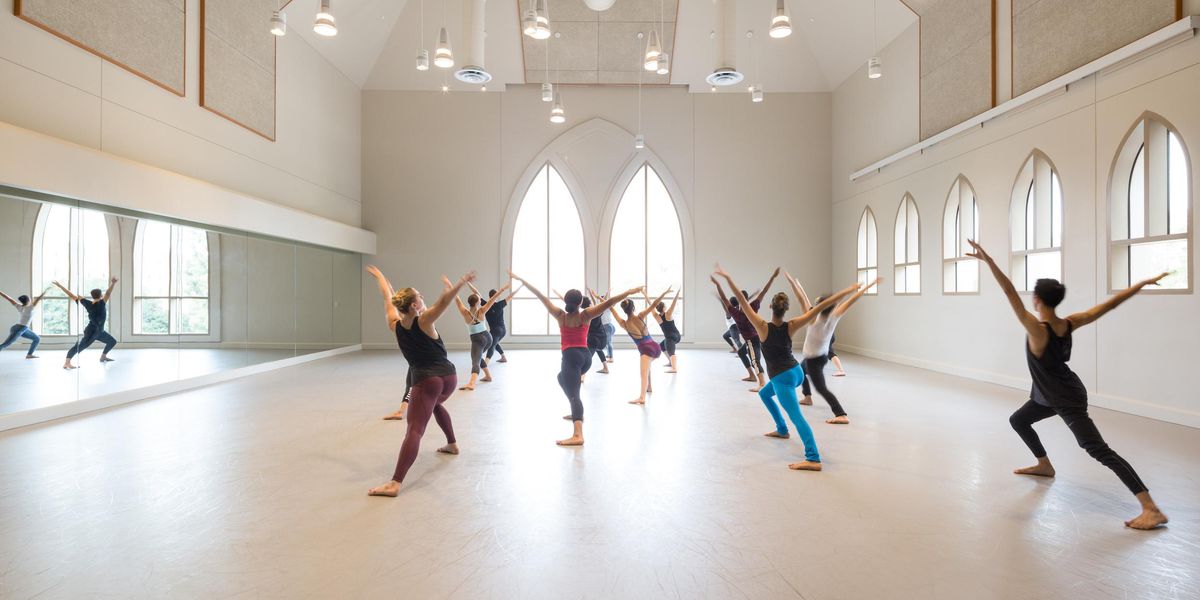Teacher's Wisdom: Linda Kent
Kent (perched on barre) teaches at Juilliard. Photo by Kyle Froman.
Linda Kent was a fiery dancer with the Paul Taylor Dance Company from 1975 to 1989. Prior to PTDC she danced for six years with Alvin Ailey American Dance Theater. Her teaching resumé includes the Juilliard School, the Ailey/Fordham BFA program, the Taylor school, and summers at Perry-Mansfield Performing Arts Camp, where she directs the dance program. With nearly four decades of teaching to her credit, Kent is a leading advocate for what the principles of classic modern technique can do for today’s dancer. Nancy Wozny talked with her about everything from dancing without mirrors to being present in your “three-millionth plié.”
How do you describe what you teach? My students joke and call it “Tailey,” as in a combination of Taylor and Ailey.
What are the characteristics of Taylor’s technique?
Going back to Graham’s roots, we use a deep contraction; movement emanates from the center of the body. There is a use of weight through the floor and through space, so that movement has a certain fluidity or connectivity.
How does using the Taylor repertory during class develop a strong dancer?
It encompasses so many ways of moving. Taylor has such a broad vocabulary, from physical to abstract dances. I can create a class using movement from just one piece. You can find adagio, movement across the floor, and varying dynamics in most of Taylor’s pieces.
How does your time with Ailey inform your teaching?
Ailey was interested in individuals and their stories. There’s always a narrative in his pieces, and that stays with me. His company was a repertory company, so I also danced in works by Joyce Trisler, Norman Walker, Talley Beatty, Limón, John Butler, and others. From them and Ailey, I get my panther edge. I don’t want to just settle for lyrical. I like guts too.
You work with students in several different contexts, from summer intensives at Perry Mansfield to daily class at Juilliard. Does your teaching shift based on the environment?
Yes, it does. At Juilliard, my students arrive directly from ballet class, so it’s time to build on that and explore other ways of moving, finding a different type of equilibrium that takes you off balance and able to return. At Perry Mansfield, my students arrive in a cold studio in the Rocky Mountains, so I might start with running to get everything going.
You often begin class by moving through space rather than standing in one place. It makes so much sense, yet that’s rarely how a class starts out.
Starting with traveling movements—reaching, stretching, circling—reminds students that they are not rooted in one place. Going off balance and coming back on, transferring weight—those are the jobs of the modern dancer. That’s what we do. Even my pliés involve rounding the torso or side bending.
How has your perspective on teaching changed?
I certainly know more about anatomy and kinesiology. I’ve audited Irene Dowd’s class at Juilliard. It was Finis Jhung who brought me into the science of dance. He approaches dance from a physics perspective. It’s full of common sense. It really changed my dancing and my teaching.
You are not a fan of mirrors. Why not?
Well, we never used mirrors at the Taylor studio, and at Juilliard we have a choice to close the curtains. I don’t want to see movement pasted on from the outside. You need to get it from the source—yourself—and feel that three-dimensionality. Otherwise, there’s a huge disconnect when you get out onstage.
Your generous dancing and effervescent personality infuse your teaching.
I always wanted to be a dancing person, not an object. No matter how abstract a dance is, there is still a human being in it. There’s a story going on in your head, even if it’s not exactly a narrative. It could be as simple as “drop, breathe, expand.” Images help; students always want that. I use Leonardo’s body-circle drawing as a way to convey energy coming from every direction. Sometimes I use sounds to vocalize movement. Sounds can work like images and sometimes better.
Do you have a philosophy for students taking your class?
My philosophy is: Know where your mind is and what it’s doing. You need to bring yourself to class and dance with your fellow beings. You need to have the sensibility of generosity exuding from you that makes us want to watch. You have to fully inhabit movement. It may be your three-millionth plié: See it, be it. Choreographers are always talking about dancers as clay to be molded. They want sentient clay—living, breathing. That’s how their vision comes to life. They need that ineffable you to make it live. That quality doesn’t wait for the stage, it begins right in class. You need to make the audience want to cross over the footlights to be part of it.
What keeps you in the profession?
I learn something in every class—a new way to teach something—and I will think, All right, they get it. I love it when those lightbulbs go on.




